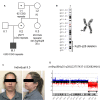Skewed X-Chromosome Inactivation and Compensatory Upregulation of Escape Genes Precludes Major Clinical Symptoms in a Female With a Large Xq Deletion
- PMID: 32194616
- PMCID: PMC7064548
- DOI: 10.3389/fgene.2020.00101
Skewed X-Chromosome Inactivation and Compensatory Upregulation of Escape Genes Precludes Major Clinical Symptoms in a Female With a Large Xq Deletion
Abstract
In mammalian females, X-chromosome inactivation (XCI) acts as a dosage compensation mechanism that equalizes X-linked genes expression between homo- and heterogametic sexes. However, approximately 12-23% of X-linked genes escape from XCI, being bi-allelic expressed. Herein, we report on genetic and functional data from an asymptomatic female of a Fragile X syndrome family, who harbors a large deletion on the X-chromosome. Array-CGH uncovered that the de novo, terminal, paternally originated 32 Mb deletion on Xq25-q28 spans 598 RefSeq genes, including escape and variable escape genes. Androgen receptor (AR) and retinitis pigmentosa 2 (RP2) methylation assays showed extreme skewed XCI ratios from both peripheral blood and buccal mucosa, silencing the abnormal X-chromosome. Surprisingly, transcriptome-wide analysis revealed that escape and variable escape genes spanning the deletion are mostly upregulated on the active X-chromosome, precluding major clinical/cognitive phenotypes in the female. Metaphase high count, hemizygosity concordance for microsatellite markers, and monoallelic expression of genes within the deletion suggest the absence of mosaicism in both blood and buccal mucosa. Taken together, our data suggest that an additional protective gene-by-gene mechanism occurs at the transcriptional level in the active X-chromosome to counterbalance detrimental phenotype effects of large Xq deletions.
Keywords: AR; RP2; X-chromosome deletion; X-chromosome inactivation; escape genes; transcriptome-wide analysis.
Copyright © 2020 Santos-Rebouças, Boy, Vianna, Gonçalves, Piergiorge, Abdala, dos Santos, Calassara, Machado, Medina-Acosta and Pimentel.
Figures

Similar articles
-
Understanding the Landscape of X-linked Variants Causing Intellectual Disability in Females Through Extreme X Chromosome Inactivation Skewing.Mol Neurobiol. 2020 Sep;57(9):3671-3684. doi: 10.1007/s12035-020-01981-8. Epub 2020 Jun 20. Mol Neurobiol. 2020. PMID: 32564284
-
Identification of skewed X chromosome inactivation using exome and transcriptome sequencing in patients with suspected rare genetic disease.BMC Genomics. 2024 Apr 16;25(1):371. doi: 10.1186/s12864-024-10240-2. BMC Genomics. 2024. PMID: 38627676 Free PMC article.
-
5meCpG epigenetic marks neighboring a primate-conserved core promoter short tandem repeat indicate X-chromosome inactivation.PLoS One. 2014 Jul 31;9(7):e103714. doi: 10.1371/journal.pone.0103714. eCollection 2014. PLoS One. 2014. PMID: 25078280 Free PMC article.
-
Escape From X-Chromosome Inactivation: An Evolutionary Perspective.Front Cell Dev Biol. 2019 Oct 22;7:241. doi: 10.3389/fcell.2019.00241. eCollection 2019. Front Cell Dev Biol. 2019. PMID: 31696116 Free PMC article. Review.
-
Dosage compensation in mammals: fine-tuning the expression of the X chromosome.Genes Dev. 2006 Jul 15;20(14):1848-67. doi: 10.1101/gad.1422906. Genes Dev. 2006. PMID: 16847345 Review.
Cited by
-
Understanding the Landscape of X-linked Variants Causing Intellectual Disability in Females Through Extreme X Chromosome Inactivation Skewing.Mol Neurobiol. 2020 Sep;57(9):3671-3684. doi: 10.1007/s12035-020-01981-8. Epub 2020 Jun 20. Mol Neurobiol. 2020. PMID: 32564284
-
Identification of skewed X chromosome inactivation using exome and transcriptome sequencing in patients with suspected rare genetic disease.BMC Genomics. 2024 Apr 16;25(1):371. doi: 10.1186/s12864-024-10240-2. BMC Genomics. 2024. PMID: 38627676 Free PMC article.
-
Molecular cytogenetic characterization of a de novo derivative chromosome X with an unbalanced t(X;9) translocation in a fetus and literature review.Mol Cytogenet. 2022 Jun 27;15(1):24. doi: 10.1186/s13039-022-00603-3. Mol Cytogenet. 2022. PMID: 35761368 Free PMC article.
-
Methylation status of genes escaping from X-chromosome inactivation in patients with X-chromosome rearrangements.Clin Epigenetics. 2021 Jun 30;13(1):134. doi: 10.1186/s13148-021-01121-6. Clin Epigenetics. 2021. PMID: 34193245 Free PMC article.
-
X Chromosome Inactivation Pattern and Pregnancy Outcome of Female Carriers of Pathogenic Heterozygous X-Linked Deletions.Front Genet. 2021 Dec 17;12:782629. doi: 10.3389/fgene.2021.782629. eCollection 2021. Front Genet. 2021. PMID: 34976017 Free PMC article.
References
-
- Andrews S. (2010). FastQC - A quality control tool for high throughput sequence data., http://www.bioinformatics.babraham.ac.uk/projects/fastqc/
LinkOut - more resources
Full Text Sources
Molecular Biology Databases
Research Materials
Miscellaneous

